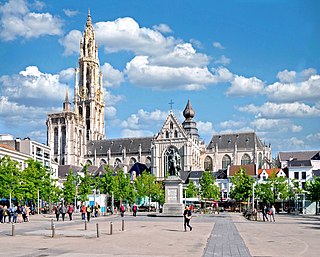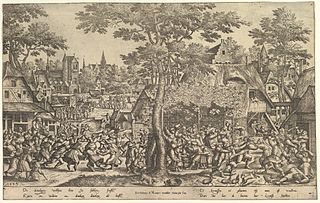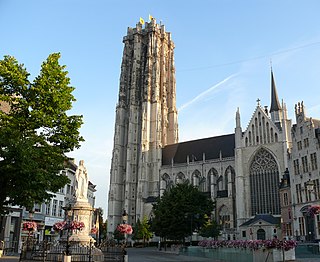The Antwerp School was a school of artists active in Antwerp, first during the 16th century when the city was the economic center of the Low Countries, and then during the 17th century when it became the artistic stronghold of the Flemish Baroque under Peter Paul Rubens.

Flemish Baroque painting was a style of painting in the Southern Netherlands during Spanish control in the 16th and 17th centuries. The period roughly begins when the Dutch Republic was split from the Habsburg Spain regions to the south with the Spanish recapturing of Antwerp in 1585 and goes until about 1700, when Spanish Habsburg authority ended with the death of King Charles II. Antwerp, home to the prominent artists Peter Paul Rubens, Anthony van Dyck, and Jacob Jordaens, was the artistic nexus, while other notable cities include Brussels and Ghent.

The Diocese of Antwerp is a Latin Church ecclesiastical territory or diocese of the Catholic Church in Belgium. The diocese was restored in 1961. It is a suffragan in the ecclesiastical province of the metropolitan Archdiocese of Mechelen-Brussels. Its cathedra is found within the Cathedral of Our Lady.

Cornelis Huysmans was a Flemish landscape painter who was active in Antwerp, Brussels and Mechelen. Huysmans held a foremost position in Flemish landscape painting in the late 17th and early 18th century and was particularly known for his pseudo-Italianate landscapes with mountains in the background, which show the influence of Nicolas Poussin and Jacques d'Arthois.

Charles Emmanuel Biset or Karel Emmanuel Biset was a Flemish painter who had a peripatetic career working in various cities and countries including his hometown Mechelen, Paris, Annonay, Brussels, Antwerp and Breda. He worked in many genres including genre scenes of interiors with merry companies and gallery paintings, history painting, still life and portraiture.

Pieter van Bredael or Peeter van Bredael (1629–1719) was a Flemish painter specializing in market scenes and village feasts set in Italianate landscapes or contemporary, usually, urban environments.

Sculpture in Brussels is sculpture that has been created in Brussels, Belgium, since the Middle Ages to the present day. It began to shine in the second half of the 14th century with Claus Sluter's arrival in Brussels and the construction of Brussels' Town Hall. It continued without interruption and reached its momentum during 15th and 16th centuries. Until the end of the Ancien Régime, sculptors in Brussels were members of the Quatre Couronnés Guild of the Nation of St Nicholas and then the Royal Academy of Fine Arts.

Pieter van der Borcht (I) or Peter van der Borcht (c. 1530–1608) was a Flemish Renaissance painter, draughtsman and etcher. He is regarded as one of the most gifted botanical painters of the 16th century. Pieter van der Borcht the Elder also introduced new themes, such as the "monkey scene" (also called singerie) into Northern art.
Events from the 1580s in the Spanish Netherlands and Prince-bishopric of Liège.

The Archdiocese of Mechelen–Brussels is a Latin Church ecclesiastical territory or archdiocese of the Catholic Church in Belgium. It is the primatial see of Belgium and the centre of the ecclesiastical province governed by the Archbishop of Mechelen–Brussels, which covers the whole of Belgium. It was formed in 1559 and the bishop has a seat in two cathedrals, St. Rumbold's Cathedral in Mechelen and the Cathedral of St. Michael and St. Gudula in Brussels. The current archbishop is Luc Terlinden, who was installed in September 2023.

Jan Frans van de Velde (1779–1838) was the 20th bishop of Ghent, in Belgium, from November 1829 until his death.








